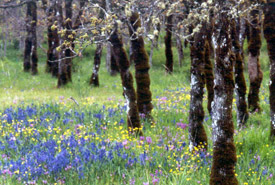Citizenship and biodiversity conservation

Cowichan Garry Oak Preserve, British Columbia (Photo by Tim Ennis/NCC)
Biodiversity conservation is no longer a topic reserved for scientists. It’s an issue that impacts all Canadians. That’s the message that was repeated by panelists at a University of Manitoba discussion on biodiversity that I attended a few weeks ago. Panelists consistently noted the importance of an informed and engaged populace to successful long-term biodiversity conservation efforts.
James MacKenzie of the Office of the Auditor General of Canada presented a recent report by his office that notes that, by most measures, the state of biodiversity in Canada is in decline. Panelists challenged each other and the audience: how do we move people beyond just knowing this fact to caring, and beyond that, to acting?
Panelist Stephen Petersen of the Assiniboine Park Zoo suggested that one of the key steps to getting people to care is to engage them and make biodiversity part of our daily conversations. He encouraged attendees to start this conversation, to share their amazement and wonder at the natural world with others in their day-to-day lives and to encourage others to ask questions, knowing how wonderful it is that we don’t know many of the answers: Why is this flower yellow and not blue? Why does this ladybug have seven spots and not nine? How does that bird make it through this hard winter? By nurturing a sense of wonder and awe, ecosystems and the species that comprise them become a resource that people understand, care about, value and protect.
Jim Duncan of the Government of Manitoba’s Conservation and Water Stewardship Department said something that really resonated with me: He noted that society has given him and his colleagues in the biodiversity conservation field (including me!) the opportunity to work in amazing careers where they strive daily to examine, study, conserve and report on biodiversity.
Duncan suggested that people and society care about biodiversity, and want to know how it's faring. He further noted that it is our duty as conservation biologists to share what we have learned with the public, to give them the information they need to make informed choices.
Panelist Nicky Koper of the University of Manitoba (who also sits on the Nature Conservancy of Canada's Scientific Advisory Committee in the Manitoba Region) and James MacKenzie both agreed that some of the most successful biodiversity conservation initiatives have been those related to waterfowl. The participation of an informed, engaged constituency of waterfowl-lovers who feel a duty to protect wetlands and the species that depend on them has been a crucial part of this success.
I am humbled daily by the Nature Conservancy of Canada’s amazing supporters and volunteers who feel charged, as Canadians, to take personal action to conserve biodiversity. These supporters are key to spreading the national conversation even wider.
By the end of the panel discussion I felt personally motivated to become more involved in this conversation, to do my small part to help foster an informed and engaged populace who feels a duty to take personal action to ensure Canada’s amazing biodiversity heritage is conserved. With this as a foundation, I am hopeful for the future of biodiversity in Canada.


